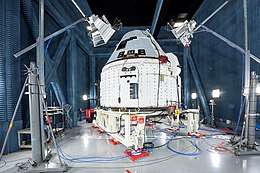Boeing Orbital Flight Test 2
The Boeing Orbital Flight Test 2 (also known as Boe-OFT 2) is a planned repeat of the Boeing's first Orbital Flight Test that was plagued with software problems. The mission will test the CST-100 Starliner spacecraft, built by Boeing as part of NASA's Commercial Crew Program. The mission is planned to last eight days, involving a rendezvous and docking with the International Space Station (ISS), followed by landing in the western United States. This is the first planned docking of Starliner after the December 2019 flight failed to rendezvous with the station due to an anomaly with the spacecraft's mission elapsed time (MET) clock. The mission is planned to use the hardware, Starliner, and Atlas V that was planned for the crewed flight test.
 Spacecraft 2 in preparation for OFT-2 | |
| Mission type | Test flight |
|---|---|
| Operator | |
| Mission duration | 6 days (planned) |
| Spacecraft properties | |
| Spacecraft | Boeing Starliner Spacecraft 2 |
| Manufacturer | Boeing |
| Start of mission | |
| Launch date | 13 November 2020 (planned)[1][2] |
| Rocket | Atlas V N22 |
| Launch site | Cape Canaveral, SLC-41 |
| End of mission | |
| Landing date | 18 November 2020 |
| Landing site | White Sands Missile Range |
| Orbital parameters | |
| Reference system | Geocentric |
| Regime | Low Earth |
| Inclination | 51.66° |
| Docking with ISS | |
| Docking port | Harmony forward or zenith |
| Docking date | 14 November 2020 (planned) |
| Undocking date | 18 November 2020 (planned) |
| Time docked | 4 days (planned) |
Commercial Crew Development Boeing Starliner flights | |
On 6 April 2020, Boeing announced that they would redo the Orbital Flight Test to prove and meet all of the test objectives. A four-month investigation of the first Orbital Flight Test resulted in Boeing proposing another uncrewed flight test of the spacecraft's systems. NASA accepted the proposal from Boeing to do another uncrewed test flight at no cost to the American taxpayers.
The cost for the second flight is an estimated $410 million. The Starliner is scheduled for launch no earlier than 13 November 2020.[1][3]
Payload
The capsule will carry approximately 600 lb (270 kg) of supplies and test equipment to simulate future missions with astronauts and their cargo onboard.
Mission
The second Atlas V N22, designated AV-082, will launch the CST-100 Starliner spacecraft on its second uncrewed test flight to the International Space Station. The capsule is intended to dock with the space station, then return to Earth to land in the Western United States after an orbital shakedown cruise ahead of Boeing Crewed Flight Test.[4]
OFT 2 is the second flight of an Atlas V without a payload fairing and with a dual-engine Centaur upper stage. The dual-engine Centaur utilizes two RL10s and is required for Starliner flights in order to provide a launch trajectory that allows for a safe abort at any point in the mission.[5]
See also
- Crew Dragon
- Crew Dragon Demo-1, SpaceX's first (uncrewed) orbital mission for a capsule intended to carry crew.
References
- Davenport, Christian (6 April 2020). "After botched test flight, Boeing will refly its Starliner spacecraft for NASA". The Washington Post. Retrieved 7 April 2020.
- Harwood, William (24 June 2020). "Astronauts gear up for spacewalks amid planning for August Crew Dragon return". Spaceflight Now. Retrieved 25 June 2020.
- @BoeingSpace (6 April 2020). "We've decided to fly a second Orbital Flight Test because we are committed to the safety of those who design, build and ultimately will fly on #Starliner. Read the full statement here: boeing.mediaroom.com/2020-04-06-Boe..." (Tweet) – via Twitter.
- Burghardt, Thomas (7 July 2020). "NASA and Boeing Complete Starliner Orbital Flight Test Investigation". NASA Spaceflight.com. Retrieved 10 August 2020.
- Gebhardt, Chris (21 November 2019). "Starliner arrives at launch pad in major pre-flight milestone". NASASpaceFlight.com. Retrieved 17 December 2019.


